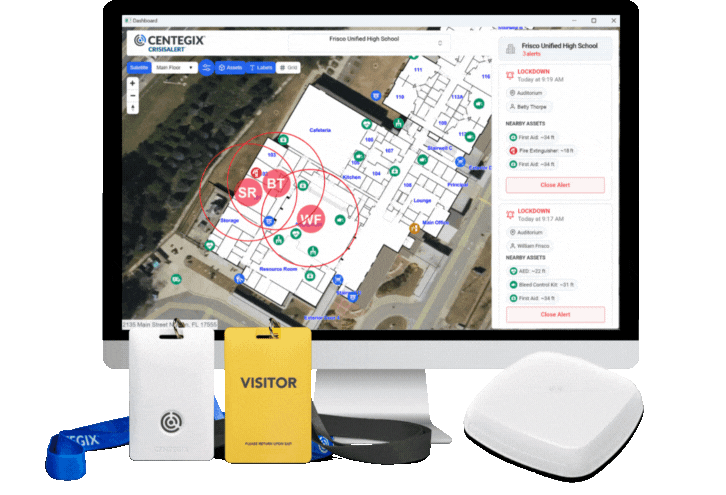Workplace violence is the act or threat of violence, ranging from verbal abuse to physical assaults, directed toward people at work. The impact of workplace violence can range from psychological issues to physical injury, or even death. Studies show that healthcare workers in psychiatric settings are at high risk for aggression from patients—leading to more instances of workplace violence in healthcare organizations.
U.S. hospitals recorded 221,400 work-related injuries and illnesses in 2019. That rate translates to 5.5 work-related injuries and illnesses for every 100 full-time employees—nearly twice the rate for private industry as a whole.
When approaching the sensitive issue of workplace violence caused by mental health episodes, the first step is to remember that combative patients need compassion, empathy, and quality healthcare. It is also important to understand the types of workplace violence, recognize the risk factors, and be aware of the negative effects that stem from the greater issue.
Once you understand the intricacies of workplace violence, you can implement policies, procedures, and secondary means of security to ensure your healthcare organization is a safe place to work and receive care.
The Importance of Empathizing with Patients

Workplace violence in healthcare
The key to approaching workplace violence caused by mental health episodes is to empathize with and understand the patient. Sometimes, it is possible to calm patients down using common methods such as careful conversation and reassurance. However, some patients are less likely to respond to those methods of de-escalation—leading to highly sensitive, potentially dangerous situations for both the patient and the caregiver. It is important to be well informed on how to remain compassionate in cases where patients become violent.
There are many risk factors that can increase the likelihood of violent behavior from patients. Patient risk factors include:
- Young age
- Male
- History of violence and/or abuse
- Substance use
- Comorbid mental health disorder
Environmental risk factors that can increase the likelihood of violent behavior from patients include:
- Crowding
- Poor staff-to-patient ratios
- Prolonged emergency department stays
- No privacy
- Poor communication among hospital staff
Patients can also become violent in acute settings, such as emergency departments or psychiatric facilities. In fact, some sources state that up to 50% of all attacks on healthcare workers occur in the emergency department. Managing these complex situations can be accomplished with verbal de-escalation, removal of triggers, or even chemical or physical restraints.
Violence may be triggered by a range of variables — from a single event or an underlying health condition such as pain, lack of sleep, medication side effects, or even overstimulation.
One of the most important ways to help combative patients is to remember that they are most likely experiencing significant changes in their health and life circumstances and treat them kindly. You may not know what they have experienced or what is happening internally, but you can remain compassionate and try to help them.
The Effect of Workplace Violence on Caregivers
Caregivers who are exposed to workplace violence are subject to experience an array of mental health issues, such as post-traumatic stress disorder, anxiety, and depression. Caregivers also experience decreased job satisfaction and burnout, leading to mental exhaustion, depersonalization, apathy, and disengagement.
Caregivers who work in a professional setting such as a hospital, in-patient or outpatient psychiatric facility, or psychologist’s office may deal with traumatized, highly emotional patients on a daily basis. This can lead to feelings of extreme tiredness and desperation. This is called compassion fatigue. Compassion fatigue is different from burnout—the term compassion fatigue describes the phenomenon of when a caregiver “takes on the suffering of patients who have experienced extreme stress or trauma.” In fact, they empathize with their patients too much — to the point where, over time, they start to become numb to what their patients are going through.
The effects of workplace violence on providers trickle down into other areas of healthcare, too. Workplace violence has been deemed a public health emergency by many, and it affects many areas of healthcare organizations:
- Patient distress
- Inadequate care
- Decreased patient satisfaction
- Healthcare costs
- Provider shortages
Reducing and Managing Workplace Violence in Healthcare

Workplace violence in healthcare
Ensuring you have effective policies and procedures such as a safety plan is crucial to dealing with workplace violence caused by mental health episodes.
It is also important to provide healthcare staff with effective means of protecting themselves as well as protecting the violent patient. As stated before — it is important to empathize with patients and remain compassionate in order to provide the best care. However, reducing violent incidents and managing the workplace doesn’t end with compassion. It is also essential for healthcare staff to have the knowledge and tools to protect themselves from harm’s way.
Caregivers should receive training on de-escalation tactics to utilize in the event they are in a high-risk situation. Some examples of de-escalation tactics include:
- Respect personal space
- Maintain effective communication skills with patients
- Remain calm
- Keep adequate physical space
- Use a panic button or call for help
- Exit the room
Other ways to mitigate workplace violence include:
- Assessing and improving physical security
- Limit access for non-employees
- Implement effective training programs
- Ensure lone workers are protected
Dealing with violent patients is a stressful task for all caregivers. However, it is possible to prevent and de-escalate situations by understanding why the patient has become violent, identifying what the patient needs, and attempting to provide care in the safest manner possible.
A Healthcare Safety Plan is the Key to Organizational Success
Healthcare organizations across the United States continue to struggle with the impact of workplace violence on their staff and patients. However, workplace violence caused by mental health episodes is an issue that can be addressed with the proper safety plan and tools.
Providing your staff the support they need during emergencies with CrisisAlert can help create and foster a culture where people feel protected and empowered in the workplace — leading to happier employees and increased patient satisfaction.
CrisisAlert’s wearable badge provides an easy, discreet, and reliable way to support your healthcare team. Employees can easily call for help from anywhere on campus, providing a quick opportunity for de-escalation. CrisisAlert can be installed with no alterations to physical structures or electrical wiring, and installation can be completed with minimal disruption to patient care.
Creating a secure environment for patients and staff is imperative to an organization’s viability. Visit CENTEGIX at centegix.com/healthcare to learn more about how CrisisAlert can help you protect your team and secure your healthcare organization. Because in a crisis, every second matters.










